火星 ALPO-Japan Latest

Mars Image 2007/09/30(UT)
Stanislas Maksmowicz,Sean Walker,Bruce Kingsley,Kolovos Dimitrios,Ralf Vandebergh,David Arditti,Dominique Dierick,Nicolas Biver,Damian Peach
S.Maksmowicz,Walker,B.Kingsley,Kolovos,R.Vandebergh,D.Arditti,D.Dierick,Nicolas,D.Peach
解説(安達)
シヌスサバエウス(Sinus Sabaeus;340W,-8)付近のダストベールは次第に晴れて
きた。北極フードの雲の塊をNicolas Biver が記録した。肉眼でも見えるとい
うのはすばらしい。北極フードは、西の端が明るいスポットに見え、目立っている。
(reported by 9 observers)
Dust veil near Sinus Sabaeus (340W,-8) came openly gradually. It is Nicolas
Biver about the lump of the clouds of the North Poler hood. It recorded.
It is wonderful that it is visible also with the naked eye. The west end
of the North Poler hood is visible to bright spot, and it is conspicuous.
(reported by 9 observers)
FROM Makoto Adachi
-------------------------------------------------------------------------------------
|
Stanislas Maksmowicz (200mm reflector) |
seeing conditions were excellent to good,
but disturbed by the seeing level at the end. Performed before second dew deposition again.
This concerns the features from CM 333 -354°.
Some comments are given in the attached files for few only.
Remain yours and will respond to your kind comments if any.
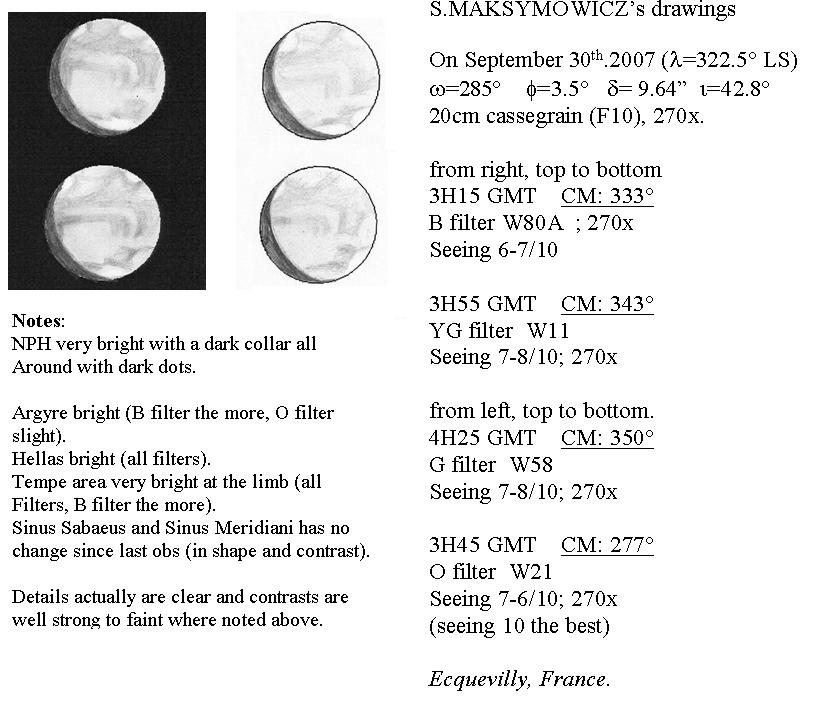 [Stanislas Maksmowicz Ecquevilly,France]
[Stanislas Maksmowicz Ecquevilly,France]
|
Sean Walker(313mm Newtonian) |
Very good seeing for the few minutes I had before the clouds shut me down. Note the "warped" appearance of the NPH.

[ Sean Walker,Massachusetts,U.S.A]
|
Bruce Kingsley(280mm SCT) |
Greetings Martians
A good observation was made considering the poor conditions here in the
UK.Although cloudy earlier on,the sky cleared in the early hours,and I was
able to image both the Moon,and Mars.
I enclose the results here :-
Seeing conditions were rather poor,but a reasonable image was captured.
The most notable part of the observation has to be the quite obvious dust
storms across Edom,Moab,Oxia Palus,and Sinus Meridiani.
The images used approximately 5000 frames for Red,and the same for Blue,
Luminance as usual was made from the Red.
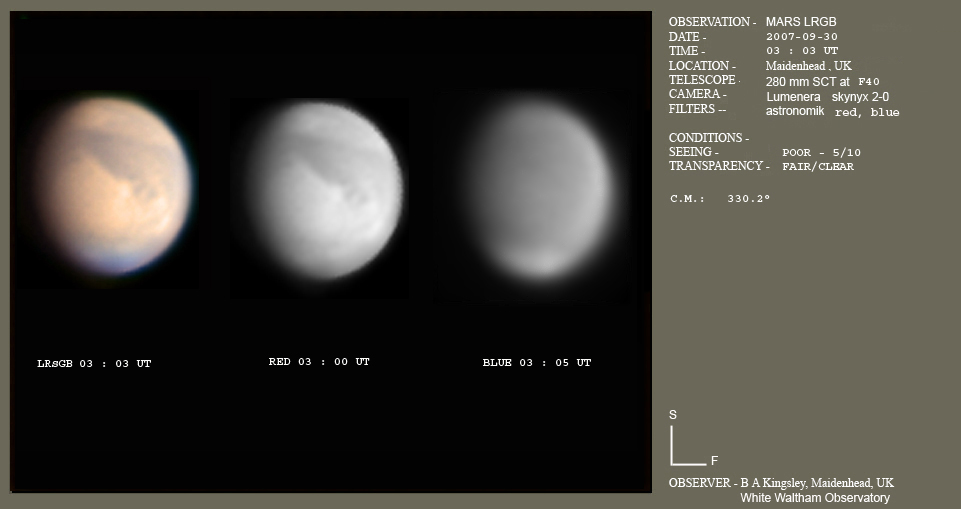 [Bruce Kingsley: Maidenhead United Kingdom]
[Bruce Kingsley: Maidenhead United Kingdom]
|
Kolovos Dimitrios ( 280mm SCT ) |
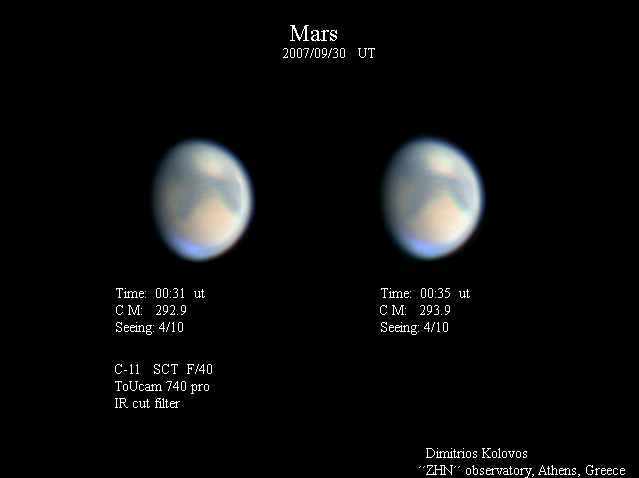
[Kolovos Dimitrios,Athens Greece]
《コロボス デミトゥリオス ギリシャ アテネ》
|
Ralf Vandebergh(250mm Newton) |
04:40-04:43UT CM=353.60-354.33)
RED 610NM & BLUE SHOTS
s:><0.7/0.6)
10IN NEWTON/ATK-1HS-11/f/24)
___________________
note:structured NPH in blue light
 [バンディバ:オランダ]
[Ralf Vandebergh:Neighbourhood of Maastricht Netherlands]
[バンディバ:オランダ]
[Ralf Vandebergh:Neighbourhood of Maastricht Netherlands]
Of the numerous Mars images I took on this morning,I thought I would send these
out as quickly as possible,as they constitute a true R,G,B image set (in
other words,not a using synthesised green),in the light of Bruce's interesting
observations on the dust. These images should give something close to a true
colour indication.
I am therefore puzzled that they do not show what Bruce's images showed,at
least,certainly not in the blue. I am getting the same light patches in the red
(also in the IR,which I will send out later) in Edom,Aram and Chryse,but
nothing noteworthy in the blue,apart from the extreme brightness of the f edge
of the NPH.
My images were taken an hour later than Bruce's. My first blue,similar to the
one given here,was taken at 03:44,39 minutes after his. Can there have been a
very short-lived phenomenon here? I was observing visually from about 03:20,but
did not see any bright patches. My blue and green filters are Type 2,which
exclude IR,and my R is Type 1,which includes it. Bruce did not say whether his
images are IR-blocked.
Apart from all this,the two-tone effect I am getting in Arabia is interesting.
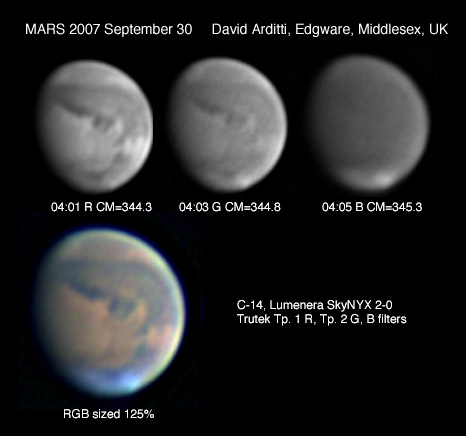 Here are my IR images from the morning of the 30th,combined with a sequence of
blue images to create (IR)(SG)B composites. These span a period of about an
hour,over which there is seen to be no real change. See also my other email.
Here are my IR images from the morning of the 30th,combined with a sequence of
blue images to create (IR)(SG)B composites. These span a period of about an
hour,over which there is seen to be no real change. See also my other email.
 Continuing to be baffled by the differences between my images of this night,and
Bruce Kingsley's,I have re-processed the R and B images in his JPEG by my own
method,to produce an R(SG)B image. I have placed under this my own
closest-timed (R)(SG)B image of 40 mins later.
I don't understand the presence of these sharply-detailed clouds in Bruce's B
image. My processing also looks very different to his. His use of a red
luminance obscured these bizarre features.
Continuing to be baffled by the differences between my images of this night,and
Bruce Kingsley's,I have re-processed the R and B images in his JPEG by my own
method,to produce an R(SG)B image. I have placed under this my own
closest-timed (R)(SG)B image of 40 mins later.
I don't understand the presence of these sharply-detailed clouds in Bruce's B
image. My processing also looks very different to his. His use of a red
luminance obscured these bizarre features.
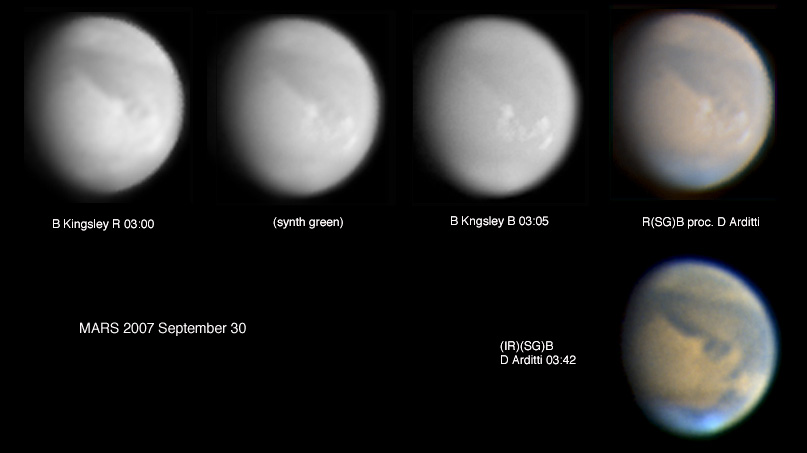 [David Arditti: Edgware Middlesex HA8 5LW: United Kingdom]
[David Arditti: Edgware Middlesex HA8 5LW: United Kingdom]
2007/09/30 00:45:00 UTCelestron
11DMK 41AF02 15fpsAstronomik RGBSeeing 5/10Trans 4/10Seeing not really
 [ Dominique Dierick:Belgium]
[ Dominique Dierick:Belgium]
I (also) had very good seeing this Sunday morning. I made 2 drawing and
a series of pictures with compact digital camera behind my Dobsonian 407mm
telescope (no tracking for sure...).
I attach here a stack of 30 1/40 to 1/50s exposures at 200 ISO behind the
T407 x 233 scope - which is far from the nice images I see on the list,
some of which (David A.s') are quite close to the visual sighting.
I also send the second drawing made at the time of sunrise for which
images where quite steady.
All usual features are visible,but Sinus Meridiani is not as dark as it
used to be (Sinus Sabaeus was definitely darker and the darkest feature
that morning) - still dusty,especially in its Southern part?
Argyre was pale yellowish,Mare Acidalium well seen with a North Polar
Hood or Polar Cap bright and emerging (a brighter patch (NPC?) at the
end of observation around CML 60 seemed to pop-up from the North).

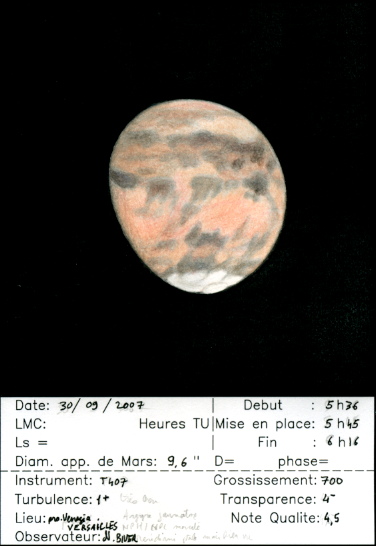 [Nicolas Biver MEUDON,FRANCE]
[Nicolas Biver MEUDON,FRANCE]
|
Damian Peach (350mm Celestron SCT) |
Here are some images from Sep 30th. Frustrating conditions due to frequent high clouds and numerous contrails. Seeing also variable and worsening near dawn.
Its amazing how much this hemisphere has cleared since i last saw it a month ago.
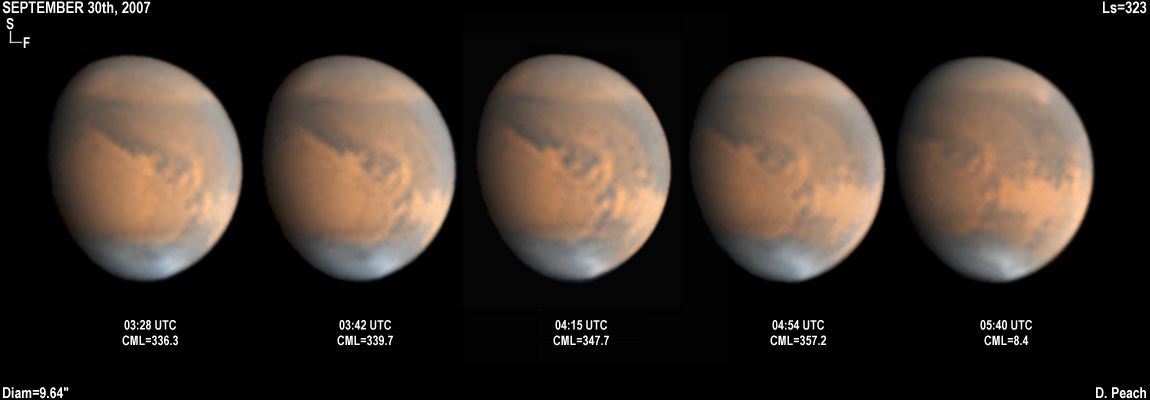
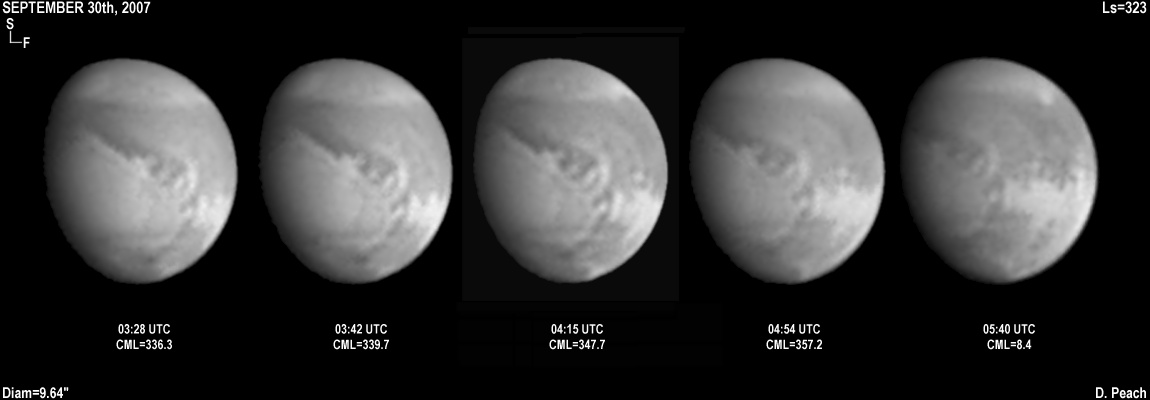
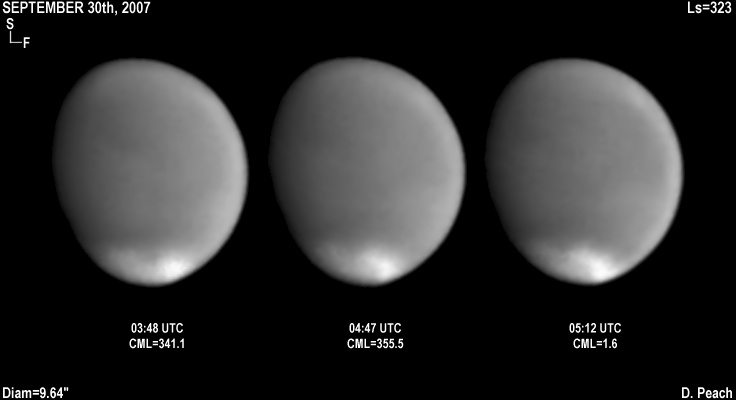
[Damian Peach: Loudwater,Buckinghamshire,United Kingdom]

 [Stanislas Maksmowicz Ecquevilly,France]
[Stanislas Maksmowicz Ecquevilly,France]
 [Bruce Kingsley: Maidenhead United Kingdom]
[Bruce Kingsley: Maidenhead United Kingdom]
 [バンディバ:オランダ]
[Ralf Vandebergh:Neighbourhood of Maastricht Netherlands]
[バンディバ:オランダ]
[Ralf Vandebergh:Neighbourhood of Maastricht Netherlands] Here are my IR images from the morning of the 30th,combined with a sequence of
blue images to create (IR)(SG)B composites. These span a period of about an
hour,over which there is seen to be no real change. See also my other email.
Here are my IR images from the morning of the 30th,combined with a sequence of
blue images to create (IR)(SG)B composites. These span a period of about an
hour,over which there is seen to be no real change. See also my other email.
 Continuing to be baffled by the differences between my images of this night,and
Bruce Kingsley's,I have re-processed the R and B images in his JPEG by my own
method,to produce an R(SG)B image. I have placed under this my own
closest-timed (R)(SG)B image of 40 mins later.
I don't understand the presence of these sharply-detailed clouds in Bruce's B
image. My processing also looks very different to his. His use of a red
luminance obscured these bizarre features.
Continuing to be baffled by the differences between my images of this night,and
Bruce Kingsley's,I have re-processed the R and B images in his JPEG by my own
method,to produce an R(SG)B image. I have placed under this my own
closest-timed (R)(SG)B image of 40 mins later.
I don't understand the presence of these sharply-detailed clouds in Bruce's B
image. My processing also looks very different to his. His use of a red
luminance obscured these bizarre features.
 [David Arditti: Edgware Middlesex HA8 5LW: United Kingdom]
[David Arditti: Edgware Middlesex HA8 5LW: United Kingdom] [ Dominique Dierick:Belgium]
[ Dominique Dierick:Belgium]
 [Nicolas Biver MEUDON,FRANCE]
[Nicolas Biver MEUDON,FRANCE]


 ALPO-Japan Latest
ALPO-Japan Latest